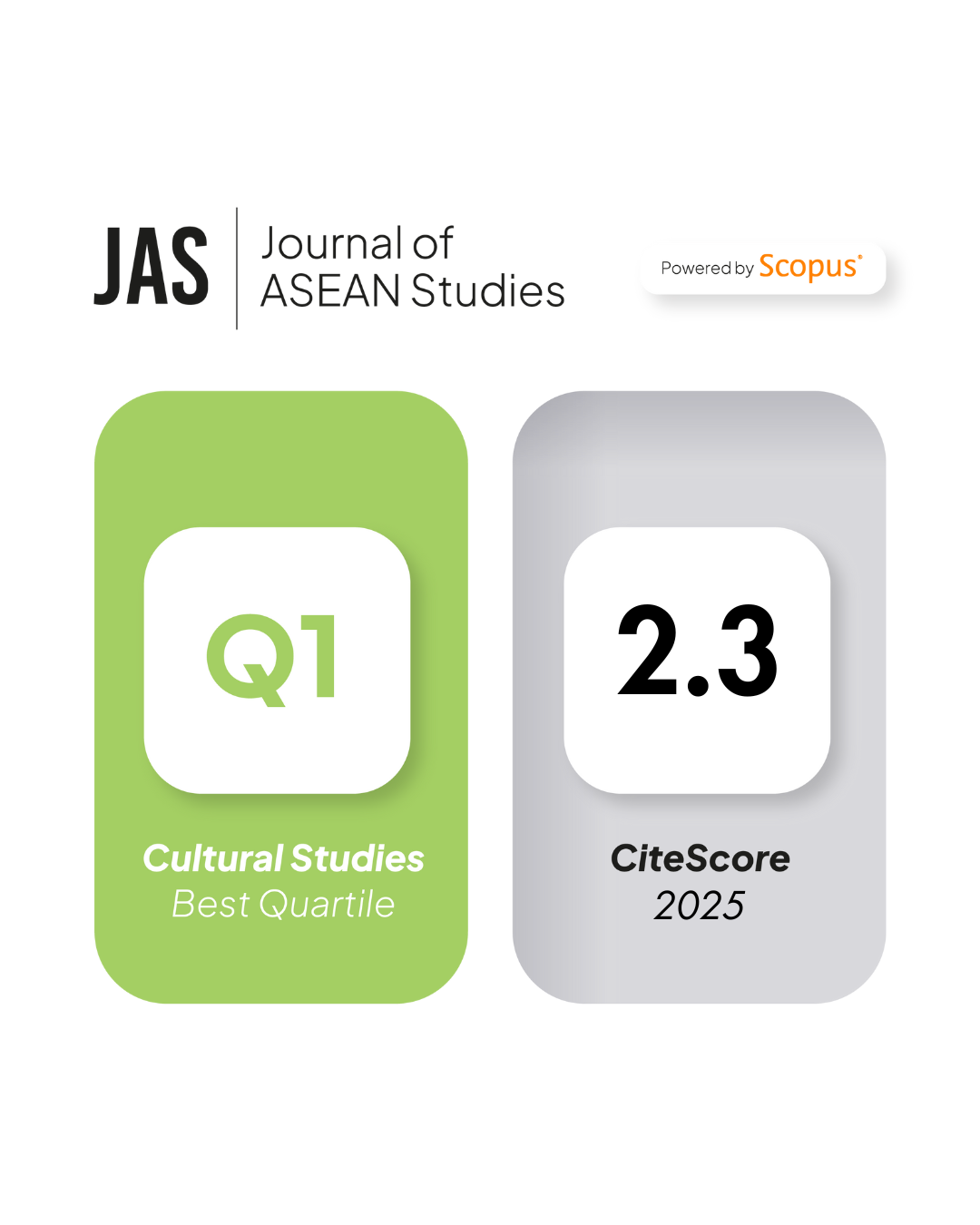Of Benevolence and Unity: Unpacking China's Policy Discourses Toward Southeast Asia
DOI:
https://doi.org/10.21512/jas.v9i1.7037Keywords:
China's Foreign Policy, Southeast Asia, Sino-Southeast Asia Relations, Social Identity Theory, Discourse AnalysisAbstract
While much attention has been directed on the security and economic implications of China’s rise in the region, research on the normative implications of China’s persistent attempt at projecting a positive major power identity continue to be lacking. This paper seeks to contribute to this growing literature, as it applies Social Identity Theory (SIT) in analyzing China’s discourses toward Southeast Asia from Mao to Xi. More specifically, it unpacks social identity phenomena within discourses reflected in official documents by using predicate analysis. Insights from the findings of this paper underscore China’s growing role as a normative power driven by a longstanding objective to be perceived positively and distinctively. Likewise, this paper also finds that there is a continuity with respect to China’s foreign policy discourse of depicting Sino-Southeast Asia relations as unique and united. There are also indications that Southeast Asia has consistently been presented as benefiting from its relations with China, thereby treating it as a prototype of what a Sino-centric order might offer for the rest of the world. Ultimately, China’s discourses of itself, Southeast Asia, and Sino-Southeast Asia relations point to major power aspirations of constructing a united in-group and a positive identity.
References
Aoyama, R. (2013). Chinese Diplomacy toward Neighboring Countries. Journal of Contemporary
East Asia Studies, 2(2): 73-93.
Association of Southeast Asian Nations. (2012). Joint Statement of the Meeting of Heads of
State/Government of the Member States of ASEAN and the President of the People’s Republic of China Kuala Lumpur, Malaysia, 16 December 1997. Retrieved February 03, 2021, from https://asean.org/?static_post=joint-statement-of-the-meeting-of-heads-of-stategovernment-of-the-member-states-of-asean-and-the-president-of-the-people-s-republic-of-china-kuala-lumpur-malaysia-16-december-1997
Beeson, M., & Li, F. (2012). Charmed or Alarmed? Reading China's regional relations. Journal of Contemporary China, 21(73), 35-51.
Boon, H. (2017). Hardening the Hard, Softening the Soft: Assertiveness and China’s Regional
Strategy. Journal of Strategic Studies 40(5): 639-662.
Callahan, W. (2016). China’s ‘‘Asia Dream’’: The Belt Road Initiative and the new regional order.
Asian Journal of Comparative Politics 1(3): 226-243.
Cheng, J. (1999). China's ASEAN Policy in the 1990s: Pushing for Regional Multipolarity.
Contemporary Southeast Asia 21(2), 176-204.
Dai, B. (2011). China is Committed to the Path of Peaceful Development. Retrieved February 03,
, from https://www.fmprc.gov.cn/mfa_eng/wjdt_665385/zyjh_665391/t860218.shtml
Deng, X. (1982). China’s Foreign Policy. In D. Xiaoping (Ed.), Selected Works of Deng
Xiaoping: Volume 2 (1975-1982). Retrieved February 03, 2021, from https://dengxiaopingworks.wordpress.com/2013/02/25/chinas-foreign-policy/
Deng, X. (1988). A New International Order Should Be Established With the Five
Principles of Peaceful Coexistence As Norms. In D. Xiaoping (Ed.), Selected Works of Deng Xiaoping: Volume 3 (1982-1992). Retrieved February 03, 2021, from https://dengxiaopingworks.wordpress.com/2013/03/18/a-new-international-order-should-be-established-with-the-five-principles-of-peaceful-coexistence-as-norms/
Deng, X. (1990). The International Situation and Economic Problems. In D. Xiaoping (Ed.),
Selected Works of Deng Xiaoping: Volume 3 (1982-1992). Retrieved February 03, 2021,
Foucault, M. (2010). The Archaeology of Knowledge and The Discourse on Language. A.M. Sheridan Smith (Trans.). New York: Vintage Books. (Original work published 1969).
Gloria, E. (2020). Constructing Major Power Identity: China’s Discourses on the Belt and Road Initiative and Policy Insights for the Philippines. In Arugay, A., & Kraft, H. (Eds.), Toward an Enhanced Strategic Policy in the Philippines (pp. 87-106). Quezon City : University of the Philippines, Center for Integrative Studies
Goh, E. (2014). The Modes of China’s Influence: Cases from Southeast Asia. Asian Survey 54(5): 825-848.
Hogg, M., Deborah T., & White, K. (1995). A Tale of Two Theories: A Critical Comparison of
Identity Theory with Social Identity Theory. Social Psychology Quarterly 58, 255–69.
Hu, J. (1998). Address by Vice President Hu Jintao at China-ASEAN Informal Leadership Meeting. Retrieved February 03, 2021, from https://www.fmprc.gov.cn/zdjn/eng/zywj/t270547.htm
Huong, L. (2019). China's dual strategy of coercion and inducement towards ASEAN. Pacific Review, 32(1): 20-36.
Information Office of the State Council The PRC. (2018). The Facts and China's Position on China-U.S. Trade Friction. Retrieved February 03, 2021, from http://www.xinhuanet.com/english/2018-09/24/c_137490176.htm
Jäger, S. (2001). Discourse and knowledge: Theoretical and methodological aspects of a critical
discourse and dispositive analysis. In R. Wodak & M. Meyer (Eds)., Methods of Critical Discourse Analysis (pp. 32-62). Sage Publications.
Jiang, Z. (1997). Towards a Good-Neighbourly Partnership of Mutual Trust Oriented to the 21st Century. Retrieved February 03, 2021, from https://www.fmprc.gov.cn/zdjn/eng/zywj/t270546.htm
Kim, E. (2014). Rising China and Turbulent East Asia: Asianization of China?. Pacific Focus: Inha Journal of International Studies, 29(1): 1-7.
Koremenos, B., Lipson, C., & Snidal, D. (2001). The rational design of international institutions. International Organization, 55(2), 761–799.
Larson, D. (2017). Social Identity Theory: Status and Identity in International Relations. In
W. Thompson (Ed.), The Oxford Encyclopedia of Empirical International Relations Theory. Oxford University Press. Retrieved February 03, 2021, from https://oxfordre.com/politics/view/10.1093/acrefore/9780190228637.001.0001/acrefore-9780190228637-e-290
Larson, D., and Shevchenko, A. (2010). Status Seekers: Chinese and Russian Responses to U.S. Primacy. International Security 34, 63–95.
Lee, J. (2016). Will China’s Rise Be Peaceful?: A Social Psychological Perspective. Asian Security 12, 29– 52.
Li, K. (2009). Full text of Vice Premier Li Keqiang at 6th China-ASEAN Business and
Investment Summit. Retrieved February 03, 2021, from http://ph.china-embassy.org/eng/zt/ASEAN/t895035.htm
Li, K. (2013). Remarks by H.E. Li Keqiang Premier of the State Council of the People's
Republic of China At the 16th ASEAN-China Summit. Retrieved February 03, 2021, from https://www.fmprc.gov.cn/mfa_eng/topics_665678/lkqzlcxdyldrxlhy_665684/t1089853.shtml
Li, K. (2020a). Speech by H.E. Li Keqiang Premier of the State Council of the People’s
Republic of China at the 23rd China-ASEAN Summit. Retrieved February 03, 2021, from http://english.www.gov.cn/premier/speeches/202011/13/content_WS5fade6dbc6d0f7257693f972.html
Li, K. (2020b). Speech by H.E. Li Keqiang Premier of the State Council of The People’s
Republic of China At the Third Lancang-Mekong Cooperation Leaders’ Meeting. Retrieved February 03, 2021, from http://eg.china-embassy.org/eng/zgyw/t1808937.htm
Li, M. (2019). China's Foreign Policy in Xi’s Era: Change and Continuity. Retrieved February 03,
, from https://cids.up.edu.ph/publications/discussion-papers/2019-series/2019-05/
Li, X. (2015). Applying offensive realism to the rise of China: structural incentives and Chinese
diplomacy toward the neighboring states. International Relations of the Asia-Pacific, 16(2): 241-271.
Lindgren, W., & Lindgren, P. (2017). Identity Politics and the East China Sea: China as Japan’s
‘Other’: China as Japan’s Other. Asian Politics & Policy 9: 378–401.
Liu, T., & Tsai, T. (2014). Swords into ploughshares? China's Soft Power strategy in Southeast
Asia and its challenges. Revista Brasileira de PolÃtica Internacional 57, Retrieved February 03, 2021, from https://www.scielo.br/scielo.php?script=sci_arttext&pid=S0034-73292014000300028&lng=en&tlng=en
Mao, Z. (1954a). Minutes of Chairman Mao Zedong’s First Meeting with Nehru. Wilson
Center Digital Archive. October 19, 1954. Retrieved February 03, 2021, from https://digitalarchive.wilsoncenter.org/document/117825
Mao, Z. (1954b). Minutes of Chairman Mao Zedong’s First Meeting with Nehru. Wilson
Center Digital Archive. October 23, 1954. Retrieved February 03, 2021, from https://digitalarchive.wilsoncenter.org/document/117815
Mao Z. (1963). Memorandum of Chairman Mao Zedong’s Conversation with Prince
Sihanouk. Wilson Center Digital Archive. February 15, 1963. Retrieved February 03, 2021, from https://digitalarchive.wilsoncenter.org/document/117953
Ministry of Foreign Affairs of the People’s Republic of China (MOFA PRC) (2014). Chairman
Mao Zedong's Theory on the Division of the Three World and the Strategy of Forming an Alliance Against an opponent. Retrieved February 03, 2021, from https://www.fmprc.gov.cn/mfa_eng/ziliao_665539/3602_665543/3604_665547/t18008.shtml
Pang, Z. (2020). From Tao Guang Yang Hui to Xin Xing: China’s Complex Foreign Policy
Transformation and Southeast Asia. Retrieved February 03, 2021, from https://www.iseas.edu.sg/wp-content/uploads/2020/04/TRS7_20.pdf
Qin, Y. (2014). Continuity through Change: Background Knowledge and China’s International
Strategy. The Chinese Journal of International Politics, (7)3: 285-314.
Reeves, J. (2018). Imperialism and the Middle Kingdom: the Xi Jinping administration’s
peripheral diplomacy with developing states, Third World Quarterly 39(5): 976-998.
Rüland, J., & Michael, A. (2019). Overlapping regionalism and cooperative hegemony: how China
and India compete in South and Southeast Asia. Cambridge Review of International Affairs, 32(2): 178-200.
Smith, S. (2021). Harmonizing the periphery: China’s neighborhood strategy under Xi Jinping,
The Pacific Review 34 (1): 56-84.
Song, W. (2020). China’s Normative Foreign Policy and Its Multilateral Engagement in Asia.
Pacific Focus: Inha Journal of International Studies 35(2): 229-249.
Storey, I. (2012). China’s Bilateral Defense Diplomacy in Southeast Asia. Asian Security, 8(3):
-310.
Strangio, S. (2020). China’s Southeast Asian ‘Vaccine Diplomacy’ Comes Into Relief. Retrieved
February 03, 2021, from https://thediplomat.com/2020/11/chinas-southeast-asian-vaccine-diplomacy-comes-into-relief/
Suehiro, A. (2017). China’s offensive in Southeast Asia: regional architecture and the process of
Sinicization. Journal of Contemporary East Asia Studies, 6(2): 107-131.
Tajfel, H and Turner, J. (1986). The Social Identity Theory of Intergroup Behavior. In S. Worshel
& W. Austin (Eds.), Psychology of Intergroup Relations (pp. 276–93). Chicago: Nelson Hall.
Takahara, A. (2012). The Rise of China and Its Neighborhood Diplomacy: Implications for
Japanese Foreign Policy. Journal of Contemporary East Asia Studies, 1(1): 47-71.
Tan, C., & Maulia, E. (2020). Red Pill? Behind China's COVID-19 vaccine diplomacy: Southeast
Asia bargains with Beijing for lifesaving drugs. Retrieved February 03, 2021, from
https://asia.nikkei.com/Spotlight/The-Big-Story/Red-Pill-Behind-China-s-COVID-19-vaccine-diplomacy
Tong, X. (2011). China-ASEAN: A model of good-neighborliness and friendly co-op.
Retrieved February 03, 2021, from http://www.china.org.cn/opinion/2011-07/03/content_22911782.htm
Van Dijk, T. (1993). Principles of Critical Discourse Analysis. Discourse & Society 4(2): 249-283.
Van Dijk, T.A. (2001). Multidisciplinary CDA: a plea for diversity. In R. Wodak & M. Meyer
(Eds)., Methods of Critical Discourse Analysis (pp. 95-121). Sage Publications.
Wen, J. (2011). Statement by H.E. Wen Jiabao Premier of the State Council of the People's
Republic of China At the 14th China- ASEAN Summit as a Commemorative Summit To Celebrate the 20th Anniversary of China-ASEAN Relations. Retrieved February 03, 2021, from http://ph.china-embassy.org/eng/zt/ASEAN/t895072.htm
Wodak, R. (2001). What CDA is about—a summary of its history, important concepts and its
developments. In R. Wodak & M. Meyer (Eds)., Methods of Critical Discourse Analysis (pp. 1-14). Sage Publications.
Wodak, R. (2001). The discourse-historical approach. In R. Wodak & M. Meyer (Eds)., Methods
of Critical Discourse Analysis (pp. 63-94). Sage Publications.
Wong, L. (2007). China–ASEAN and Japan–ASEAN Relations during the Post-Cold War Era.
Chinese Journal of International Politics 1(3), 373-404.
Xi, J. (2013). Speech by Chinese President Xi Jinping to Indonesian Parliament. Retrieved
February 03, 2021, from http://www.asean-china-center.org/english/2013-10/03/c_133062675.htm
Xi, J. (2015). Xi Jinping’s speech at National University of Singapore. Retrieved February
, 2021, from http://www.whcy.ynu.edu.cn/info/1128/1275.htm
Xinbo, W. (2016). Cooperation, competition and shaping the outlook: the United States and China’s neighbourhood diplomacy. International Affairs, 92(4): 849- 867.
Xu, J. (2011). The Two Poles of Confucianism: A Comparison of the Interstate Political Philosophies of Mencius and Xunzi. In X. Yan (Ed.), Ancient Chinese Thought, Modern Chinese Power (pp. 161-180). New Jersey: Princeton University Press.
Yan, X. (2018). Chinese Values vs. Liberalism: What Ideology Will Shape the International Normative Order?. Chinese Journal of International Politics 11(1): 1-22.
Zheng, B. (2005). China’s Peaceful Rise: Speeches of Zheng Bijian. Washington, D.C.: Brookings University Press.
Zhou E. (1955). Main Speech by Premmier Zhou Enlai, Head of the Delegation of the People’s
Republic of China. Retrieved February 03, 2021, from https://digitalarchive.wilsoncenter.org/document/121623
Zhu, R. (1999). Address by Premier Zhu Rongji of the People’s Republic of China at the
ASEAN+1 Informal Summit 28 November 1999. Retrieved February 03, 2021, from
Downloads
Published
How to Cite
Issue
Section
License
Copyright (c) 2021 Enrico Gloria

This work is licensed under a Creative Commons Attribution-NonCommercial 4.0 International License.






















